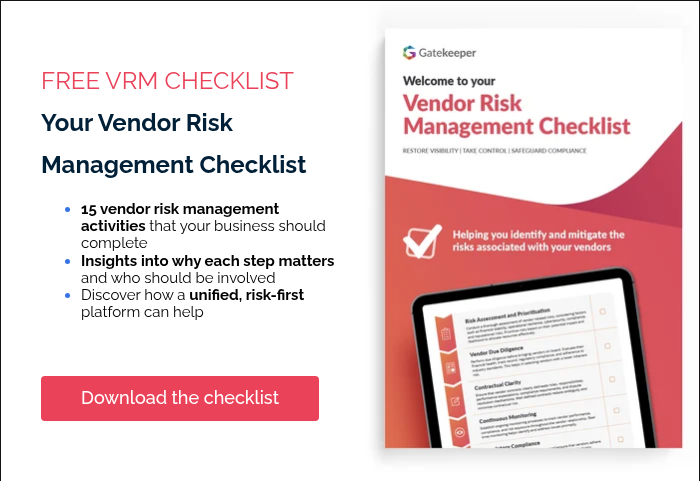The Problem with Self-Made Forms
Many organisations still rely on homegrown questionnaires to assess vendor risk. They look simple on the surface, but they hide serious flaws.
- Inconsistency: Different teams build their own forms. The result is uneven assessments and dangerous gaps.
- Poor alignment: Self-made templates rarely map cleanly to recognised standards like ISO 27001, NIST, or GDPR. When regulators review them, they don’t stand up.
- High maintenance costs: Every regulatory change necessitates a manual rewrite, and updates often arrive long after the rules have been revised.
- Subjectivity: Without scoring, assessments are open to interpretation. That makes results unreliable and vendor comparisons almost impossible.
This patchwork approach may cope with a handful of vendors. But it doesn’t scale against the realities of tightening regulations and expanding supply chains.
What feels manageable today can quickly become a source of exposure, and the cost of failure only grows as the number of third parties increases.
That’s why many organisations look to standardisation. And in third-party risk, one benchmark stands above the rest: SIG, the Standardised Information Gathering Questionnaire.
Standardisation with Standardised Information Gathering (SIG): The Industry Benchmark
The Standardised Information Gathering (SIG) Questionnaire, developed by the Shared Assessments community, is the leading standard for third-party risk assessments.
Why SIG?
- Structured and modular: Tailor assessments to vendor type and risk level.
- Mapped to regulations: Covers 21 risk domains, aligned with 31+ global frameworks.
- Continuously updated: Annual updates reflect evolving laws and threat landscapes.
- Widely recognised: Adopted by enterprises and platforms globally, enabling comparability.
With SIG, compliance teams gain a trusted, regulator-ready foundation for vendor risk onboarding.
What are the benefits of standardisation?
- Consistency: Every vendor is measured against the same yardstick, removing gaps and subjectivity.
- Defensibility: Assessments that can stand up to regulators, auditors, and the board.
- Comparability: Results that can be tracked over time and benchmarked across vendors.
- Efficiency: A repeatable process that frees teams from chasing or rewriting forms.
- Visibility: Clear data that gives procurement control, compliance confidence, and finance predictability.
Without standardisation, vendor assessments remain fragmented and reactive. With the SIG Questionnaire, organisations can scale onboarding without scaling risk - building resilience in the face of expanding supply chains, shifting regulations, and increasing scrutiny.
Going Further: The Power of Scored Forms
Standardised questionnaires lay the groundwork. But to truly manage risk at scale, you need more than a checklist.
That’s where Scored Forms come in.
They turn assessments into measurable data - giving procurement, compliance, and finance a shared view of vendor risk that can be acted on.

Benefits of Scored Forms:
- Quantify risk: Apply weights and scores to responses to produce a clear overall risk rating.
- Automate triage: Fast-track low-risk vendors to expedite onboarding, while escalating high-risk ones for more thorough review.
- Monitor over time: Track how vendor risk scores evolve across reviews, audits, and contracts.
- Remove subjectivity: Consistent scoring eliminates reviewer bias and builds defensibility.
- Drive decisions: Risk scores feed dashboards, workflows, and board reports - providing leaders the visibility they need to act with confidence.
In Gatekeeper, Scored Forms take SIG questionnaires and transform them into dynamic, weighted assessments.
Instead of static compliance checklists, you get proactive risk management - where data backs every vendor decision, and every risk call is defensible at the highest level.
|
Dimension |
With SIG Standardisation |
With Scored Forms Added |
|
Consistency |
One standard form across all vendors |
Same scoring logic across reviewers |
|
Comparability |
Benchmark vendors side by side |
Risk ratings highlight differences |
|
Efficiency |
Save time vs. DIY forms |
Automated scoring speeds onboarding |
|
Decision Support |
Data centralised in one place |
Risk thresholds trigger workflows |
|
Compliance |
Always updated with SIG releases |
Full audit trail of scores & changes |
How Gatekeeper Customers Use Scored Forms for Vendor Risk Management
Police Bank wanted vendor management to be proactive, not reactive. Too often, issues like SLA failures, cyber events, or privacy lapses were only surfaced after the fact - when they were already creating risk.
With Scored Forms in Gatekeeper, they establish a simple discipline. Each month, contract owners receive a prompt to complete a five-question check for their vendors. Every question carries a weighting. Answers generate a numeric score and a red, amber, or green status.
The questions focus on the risks that matter most:
- SLA adherence: have service levels been met?
- Cyber/security incidents: have there been any breaches?
- Privacy and data protection posture
Overall vendor performance and compliance, including regulatory requirements like CPS 230.
The scores build a timeline of performance. Trends are easy to spot. If a vendor moves from green to amber or amber to red, the team is notified early and can intervene with the contract owner or vendor before the problem escalates.
The business impact is clear:
- Faster, self-serve access to vendor evidence and status
- Less time wasted by procurement, freeing capacity for strategic priorities like RFPs and escalations
- A stronger procurement culture, with greater stakeholder buy
By using Scored Forms, Police Bank now has a proactive, data-driven rhythm for vendor management. What was once reactive firefighting is now a disciplined, transparent process that builds confidence with both procurement and leadership.
Gatekeeper Advantage: SIG + Scored Forms, Built-In
Every Gatekeeper subscription comes with:
- Access to SIG questionnaires with annual updates
- Gatekeeper’s Scored Forms module, converting responses into risk ratings automatically
That means you can start using industry-standard forms immediately, while also benefiting from automated scoring, streamlined workflows, and actionable insights.
👉 Explore SIG here: https://sharedassessments.org/sig/
👉 Contact us today for a demo and see Gatekeeper’s Scored Forms in action
Conclusion
Third-party risk is a reality. The choice is how you manage it.
DIY forms leave you exposed - inconsistent, subjective, and impossible to defend at scale.
SIG questionnaires bring structure, consistency, and regulatory alignment.
Scored Forms turn assessments into data - unlocking efficiency, comparability, and proactive decision-making.
With Gatekeeper, you don’t have to compromise. We take you from standardised SIG questionnaires to scored, automated risk assessments - giving procurement speed, compliance confidence, and the CFO the predictability they need.


.png)
.png)
.png)
-4.png)